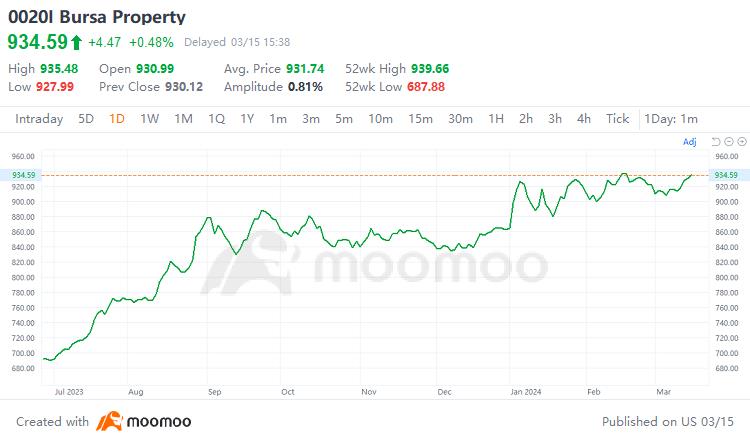Bullish Outlook for Malaysia's Property Sector Amid Economic Challenges
In 2023, the Malaysian property sector reached a historic high in transaction value. Despite this peak, the $Bursa Property(0020I.MY$ has continued to show resilience into 2024. By mid-week trading, it had surpassed 934 points, which represents a significant increase of 8.36% since the start of the year.

Analyst Optimism Post-Napic Report
Following the release of the latest National Property Information Centre (Napic) results, analysts have expressed optimism about the prospects of property stocks within the KLPI. Key factors driving this positive sentiment include supportive monetary and government policies, along with the ripple effects from major infrastructure projects.
1. Malaysia Central Bank Easing
Last Friday, the Malaysian Central Bank reported that the country's economic growth slowed to 3.7 percent in 2023, down from 8.7 percent in 2022, with this more subdued pace expected to continue until at least the end of 2025 amid global trade headwinds. Despite the slowdown, the economy still expanded by 3 percent in the last quarter of 2023, and inflation has moderated with average rates of 2.5 percent and 3.0 percent for general and core inflation, respectively.This economic easing is likely to positively impact the property market, as lower inflation typically leads to lower interest rates, making loans cheaper and potentially stimulating property investments. The Central Bank's measures and the current moderate economic conditions could thus bolster the property sector in Malaysia.
2. Malaysia Government Support Property Market
In support of the property market, the Malaysian government's policy direction in Budget 2024 focuses on enhancing housing affordability and accessibility. A total of RM2.47 billion has been allocated for housing, with RM546 million designated for 36 People Housing Programmes, aiming to provide homes for 5,100 individuals by finishing 15 PPRs by 2024.Furthermore, RM1 billion will back a guarantee fund to encourage developers to revive stalled housing projects, while the Housing Credit Guarantee Scheme's budget will increase to RM10 billion to aid 40,000 borrowers. The government will also revive the Bandar Malaysia Project, including affordable homes for military veterans. To boost tourism and investment, it contemplates relaxing rules for Malaysia My Second Home program and has removed the unanimous consent requirement for strata title en-bloc sales, fostering urban redevelopment and enabling reinvestment in new properties.
3. Infrastructural Advancements Bolstering the Property Market
The strategic development of major infrastructure projects like the High-Speed Rail (HSR), Rapid Transit System (RTS), and Mass Rapid Transit 3 (MRT3) is poised to revolutionize the convenience of transportation for residents in Malaysia. The HSR is expected to drastically cut travel times between Kuala Lumpur and Singapore, the RTS will facilitate seamless cross-border transit between Johor Bahru and Singapore, and the MRT3 Circle Line will significantly improve accessibility within the Greater Kuala Lumpur/Klang Valley area.These transformative projects will not only enhance the quality of daily commutes but also expand the spectrum of desirable residential locations. The resulting ease of mobility is a boon to the property market, likely driving demand and increasing property values across a more diverse range of locales. As these infrastructural projects progress towards completion, the real estate sector anticipates a corresponding upsurge in market activity, affirming the critical role of infrastructure in shaping prosperous property landscapes.
Inflation and Currency Impact Assessed
Inflation and the weakening ringgit appear to have a minimal impact on Malaysia's property market resilience entering 2024. Inflation, initially a concern post-Covid-19, has begun to stabilize, with consumers demonstrating a capacity to adapt to economic changes, as reflected in steady spending patterns. Loong asserts that the property sector remains robust despite currency fluctuations, with the local sourcing of construction materials cushioning potential adverse effects. Additionally, a surge in property demand, driven by savings accumulated during the pandemic, coupled with predictions of a stronger 2024 for developers due to Malaysia's economic fortitude and favorable labor market conditions, indicates sustained growth in the property market.
Strategic Stock Selections from Analysts
Loong identified $UEMS(5148.MY$, $SUNWAY(5211.MY$, and $IOIPG(5249.MY$ as top picks within the industry, citing their significant operations in Johor as the primary rationale. She elaborated that UEM Sunrise is the preferred choice for Johor's thematic play, with Sunway set to benefit from its substantial market exposure, and IOI focusing on bolstering its recurring income from property investments. Moreover, according to the Napic results, significant annual growth was observed across all major states, with Johor at the forefront with a 6.2% increase, followed by Penang, Selangor, and Kuala Lumpur.
For more company fundamentals information, please read: Visualised Financial Data at Your Fingertips: Shortcut to Know a Company's Fundamentals
Source: moomoo, the Edge Malaysia
Disclaimer: Moomoo Technologies Inc. is providing this content for information and educational use only.
Read more
Comment
Sign in to post a comment
